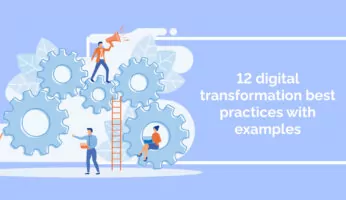
The ROI of an HCM platform is not guaranteed – in fact, it depends on a number of other factors, ranging from employee skill levels to business process design. To overcome HCM “blockers,” or the barriers to HCM ROI, it is important to manage these issues carefully.
How to Overcome 5 HCM Blockers – Barriers to HCM Success
Let’s look at some of the biggest barriers to the success of an HCM adoption program.
Employee resistance
Employee resistance is one of the most common obstacles to any organizational change project, including software-related projects, such as HCM adoption projects.
If that resistance is not handled carefully, it can become a major barrier to productivity. This in turn can drive down performance and ROI. Or, in a worst case scenario, it can even cause the failure of the adoption project.
To tackle resistance, it is important to understand its causes.
In most cases resistance stems from fear.
The fear of job displacement is one example. Today, many employees feel that software and automation is coming to take their jobs. And while that is a real concern in some cases, in others this fear can be allayed through proper communication.
If the adoption of the HCM platform does not threaten jobs, for instance, you can minimize that fear by being transparent about the impacts of the adoption plan.
Another way to tackle this obstacle is by providing employees with the skills they need to succeed in today’s digital work environment.
A lack of digital skills
The digital skills gap has become a serious concern for many organizations around the world.
Since employees need digital skills to stay productive, they also need to continually learn new skills as new tools are adopted. When employees fail to learn new skills, they contribute less to the organization and, in many instances, the organization’s performance suffers as a result.
One research study from PwC, for instance, found that a number of CEOs are concerned with the availability of key skills, suggesting that the skills gap inhibited innovation.
When we look at HCM platforms, the same holds true – a lack of skills will reduce employees’ utilization of the tool and, as a result, the HCM platform’s ROI.
The solution: employee training.
A robust, modern training approach focuses not just on job duties, but on digital skills. Using digital adoption platforms, for instance, it is possible to deliver streamlined onboarding and training experiences, without driving up the costs or complexity of training programs.
A lack of executive support
Executive sponsorship is necessary to the success of major business initiatives.
In the case of an HCM platform, the primary sponsor will typically be the CHRO.
It is important, however, to have support from other areas, especially IT.
HR, after all, must partner with IT when deploying major software platforms such as HCM Tools. Forming a partnership with IT is one of the best ways to help ensure that the program is successful.
Poor change management
HCM adoption is a form of organizational change, and if that change is not managed properly, underperformance is highly likely, if not certain.
To maximize the chances of success, take a structured approach to change management.
This means:
- Following change management best practices and procedures
- Having a dedicated change management team
- Strategically tackling obstacles to change, such as those covered in this article
- Addressing the human side of change, which revolves around areas such as effective communication, motivating employees, and reducing resistance to change
- Coordinating and managing the change project from start to finish
In many instances, having the right change management team will, by default, address many of the obstacles covered here, such as employee resistance and upskilling.
Misalignment between business units
When business units are not properly aligned, they cannot collaborate effectively. Cross-functional collaboration, however, is often needed to drive successful digital transformation efforts, particularly those that impact the entire organization.
For instance, when teams are aligned, it is possible to:
- Collect and use data throughout the organization
- Implement the same practices and processes across multiple business units
- Standardize and optimize business processes across several departments
To achieve these goals, it is necessary for business leaders and departments to build long-term partnerships and conduct operations jointly. IT and HR, for instance, should work closely together in order to manage both the technical aspects of software deployment as well as the human side of change, as noted.
It may also be necessary to get the highest levels of leadership involved to enact certain of the measures covered here. Standardizing data collection processes across the entire organization, for instance, may require support from the COO and multiple department heads.
Key Takeaways
The success of an HCM adoption program depends on many factors that are independent of the HCM platform itself. As we have seen above, these can include employee skills, employer resistance, executive support, and more.
When designing an HCM adoption program, therefore, it is important to take these factors into account and develop a plan that addresses them proactively.
WalkMe Team
WalkMe spearheaded the Digital Adoption Platform (DAP) for associations to use the maximum capacity of their advanced resources. Utilizing man-made consciousness, AI, and context-oriented direction, WalkMe adds a powerful UI layer to raise the computerized proficiency, everything being equal.



